The St. Louis Railway Exchange Building: a battle against time and absentee ownership
The former home of the Famous-Barr flagship store faces an uncertain future
Today on Unseen St. Louis, I wanted to look back at a building of great local and personal significance: the Railway Exchange Building in downtown St. Louis, located on an entire city block at 615 Olive Street. People who have been around for a while may know it as the old downtown Famous-Barr store. Recently it has been in the news because the city was forced to condemn the building in the hopes of saving it.
History of the Railway Exchange Building
The Railway Exchange Building is a historic part of downtown St. Louis. Built in 1913, the building revolutionized the shopping experience, offered new amenities and technological improvements in rental office space, and accommodated some of the city's railroad administrative offices.
The idea of the Railway Exchange Building was first conceived in 1905 by Thomas McKittrick, a partner in the Hargadine and McKittrick Dry Goods Company, with help from William Holbrook, a downtown real estate developer. Retailer David May acquired the Famous Clothing Store in 1892, and in 1911, May Department Stores purchased the struggling Barr Company from Hargadine-McKittrick with the understanding that it would occupy the lower floors of the large building that McKittrick was planning.
Designed by Mauran, Russell & Crowell, the Railway Exchange Building is a prime example of the Chicago school architectural style. This twenty-one-story, 250-foot-high building was the first building in St. Louis to reach a height of twenty floors. It boasts 5,000 windows, 1.2 million square feet of space, and the exterior is clad with a glazed cream-colored terra cotta decorated with Renaissance motifs of foliage, geometric shapes, Ionic and Corinthian details, scrolls, and human faces.
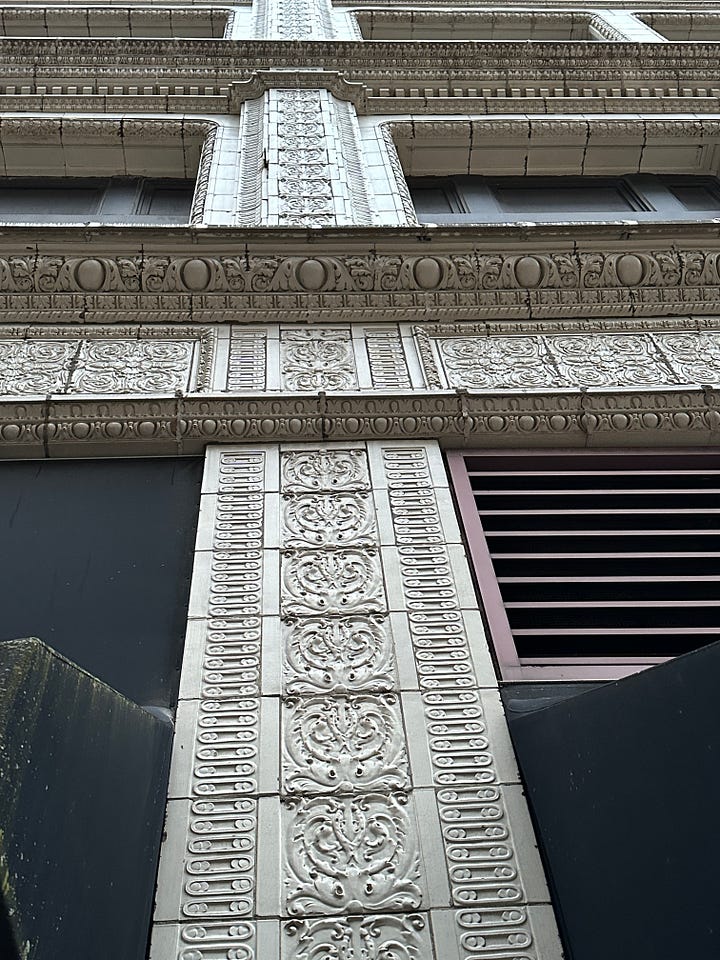
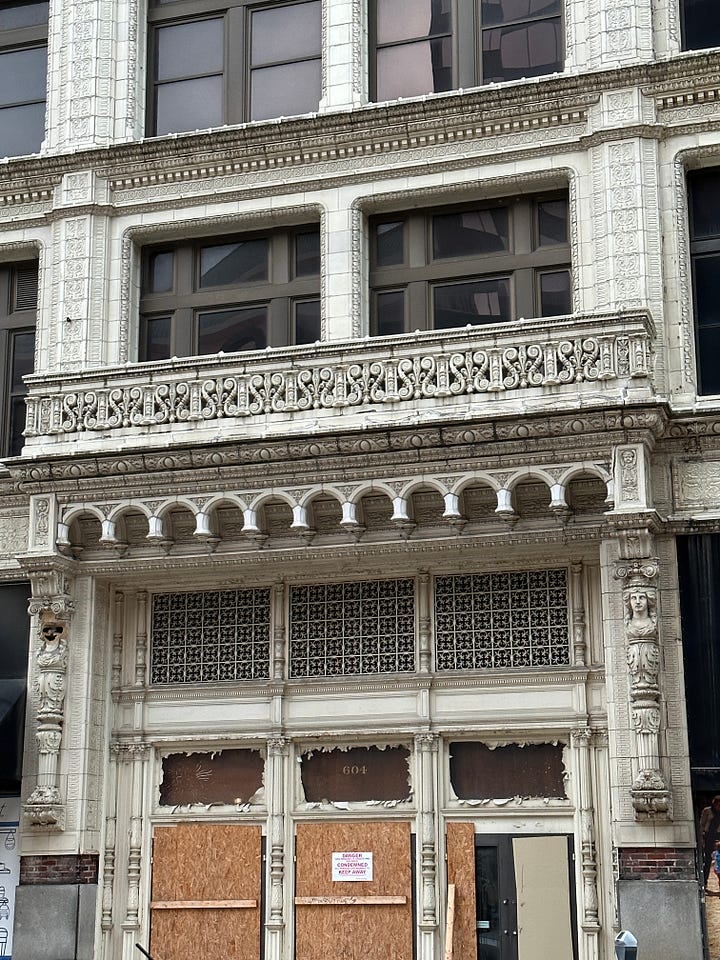
The Famous-Barr Department Store and its parent company, the May Department Stores Company, occupied the lower seven floors and the basement of the new building, representing about forty percent of its total floor space. Above, the next half dozen floors catered to the local railroad community, providing space for the headquarters of St. Louis' five major railroads: MoPac, Frisco, Wabash, Katy, and Iron Mountain and Southern, plus branch office space for more than a dozen other railroads. Professionals and small businesses rented the remaining offices above.
The department store and office building were served by separate entrances and banks of elevators, which were manually controlled with rheostats and operated on direct current.
Every one of the 105 offices on each of the upper floors had access to outside light and ventilation thanks to the interior light court above the seventh floor. The building was also equipped with a sprinkler system, automatic fire escape system, and self-contained floors for sealing off in times of emergency.
Famous-Barr installed a pneumatic tube system to transport sales slips and payments between sales stations and cashiers. There are remnants of the system on the sixth floor. Additionally, the building featured a central refrigeration system and a central kitchen to support the main dining room and employee cafeteria. Both spaces were also equipped with central vacuum cleaner systems, although the system was never used.
An eight-story brick auxiliary building was located one block north (on the south side of St. Charles, just west of Sixth Street), to support the main structure. The basement contained the machinery to produce the steam heat and electric power needed by the Railway Exchange Building. The remainder of the auxiliary building acted as a warehouse with pick-up and delivery service for the department store, connected to the main building by a tunnel.
In 1928, Famous-Barr expanded considerably, taking over the eighth to twelfth floors. New trusses installed over much of the profile of the eleventh floor allowed for a roof over the entire well below that point, with an auditorium filling some of the space on the ninth and tenth floors. The ninth floor included a new beauty salon.
In 1939 Famous-Barr became the first American department store to be completely air-conditioned, at a cost of $700,000. At that time, the company filled thirteen floors, about 75% of the building's total space. (Can you imagine being in such a large building without air conditioning? Yikes!)
St. Louis Centre
Despite the proliferation of shopping malls out in St. Louis County, May Department Stores decided to take a chance on declining downtown St. Louis. In 1985 the company built the St. Louis Centre as a shopping mall that extended north of the Railway Exchange Building and connected its flagship Famous-Barr store with its fellow department store Stix, Baer, and Fuller store on Washington Avenue. Between the anchor department stores were standard mall stores of the time, plus a McDonald’s and food court. Much of it was enclosed in glass, making it bright and sunny, unlike many traditional malls.
One of the goals of the St. Louis Centre, like so much downtown development over the past several decades, was to help ‘revitalize’ downtown. This was the same period when Union Station was transformed from a train station to a shopping mall. Build the shopping centers, and people will return to the city, or so many hoped. The problem that plagued Famous-Barr and other stores in the 1980s was that few people lived downtown during this period, and once the excitement of the grand opening had passed and the novelty wore off, people in the county weren’t likely to drive to the city to shop.
By the early 1990s—just a handful of years after St. Louis Centre opened—it was already in decline, in part due to the expansion of the Galleria in Richmond Heights. In 1996, the St. Louis-based retail company Edison Brothers Stores filed for bankruptcy, and it closed several of its stores at St. Louis Centre, including Oak Tree, Jeans West, and The Wild Pair. Then Dillards—what had once been Stix, Baer, and Fuller—reduced its downtown operation and eventually closed entirely. By 2005 there were only a few stores left, including Walgreens, Payless Shoes, GNC, and T-Mobile, and a few restaurants in the food court.
In 2004 Barry Cohen bought the mall at a foreclosure sale for $5.4 million—a bargain, since the original cost was $95 million. Two years later, Pyramid Companies purchased the building, and after auditioning several different redevelopment schemes, the company closed the 21-year-old St. Louis Centre permanently on September 15, 2006.
Personal memories
My first job, back in 1986-87, was at Famous-Barr (when it was part of the St. Louis Centre). I started out as a ‘contingent worker,’ basically, a sub or floater who could be sent to different departments.
When I was hired, the store was in the middle of a seasonal inventory, and my first assignment was bonkers. I was sent to housewares, where I was told to put tiny stickers with a C on every piece of silverware. Because this was the company's flagship store, they stocked replacement pieces of every silverware style imaginable, likely going back decades, so the stockroom was filled with rows and rows of shelves of thousands of place settings.
We spent several days working on this task, possibly one of the most tedious things I’ve ever done. Just as we finished, relieved to be done with it all, a manager came charging in and insisted that we remove all the stickers. So we did. And just about the time we finished that task, another manager came in and told us the other manager was wrong, and we needed to go back and put stickers back on all the silverware.
After that fiasco and a bit more time doing inventory, since they hadn’t run me off, they trained me on the registers (oddly, a childhood dream—I always wanted to run the ‘chunkachunk machine’ that made credit card impressions!).
And I spent many lunch breaks in the St. Louis Centre, eating at McDonald’s, shopping, or just wandering around. Back then, the mall was brand new and so very pretty, though it was rarely ever crowded.
End of an era
Back to the Railway Exchange Building.
As the St. Louis Centre struggled in the early 2000s, the Railway Exchange Building was sold by Dayton-Hudson Corporation to Federated Department Stores. Federated retired the Famous-Barr name on September 9, 2006, and the remaining Famous-Barr stores were renamed as Macy’s.
Over time, Macy's downsized its operations in the building, centralizing its operations in Chicago and Houston and eliminating most of its staff. In 2010, Macy's sold the building to developer Rick Yackey for $111.7 million, who planned a massive redevelopment of the property, including renovating the Macy's store. Unfortunately, Macy's closed the store shortly thereafter, and the redevelopment plans were put on hold.
In 2017, Hudson Holdings, a Florida-based developer, purchased the Railway Exchange Building and its parking garage for $9.5 million, with plans to create a $300 million mixed-use development. However, the project encountered many obstacles, including a water main rupture that flooded the building's basement and caused extensive damage. Hudson Holdings is currently involved in litigation with lien-holders that lent Hudson the money to acquire the building.
Building in jeopardy
The building has been empty for years, and its condition has deteriorated rapidly. Although a redevelopment plan was teased last August, the building owners subsequently have not been willing to do much to maintain the property or even respond to city officials. After news reports of broken windows and kicked-in plywood allowing looters to access the building, the police escorted out several people, and the City immediately boarded up the building and issued emergency orders to condemn the property.
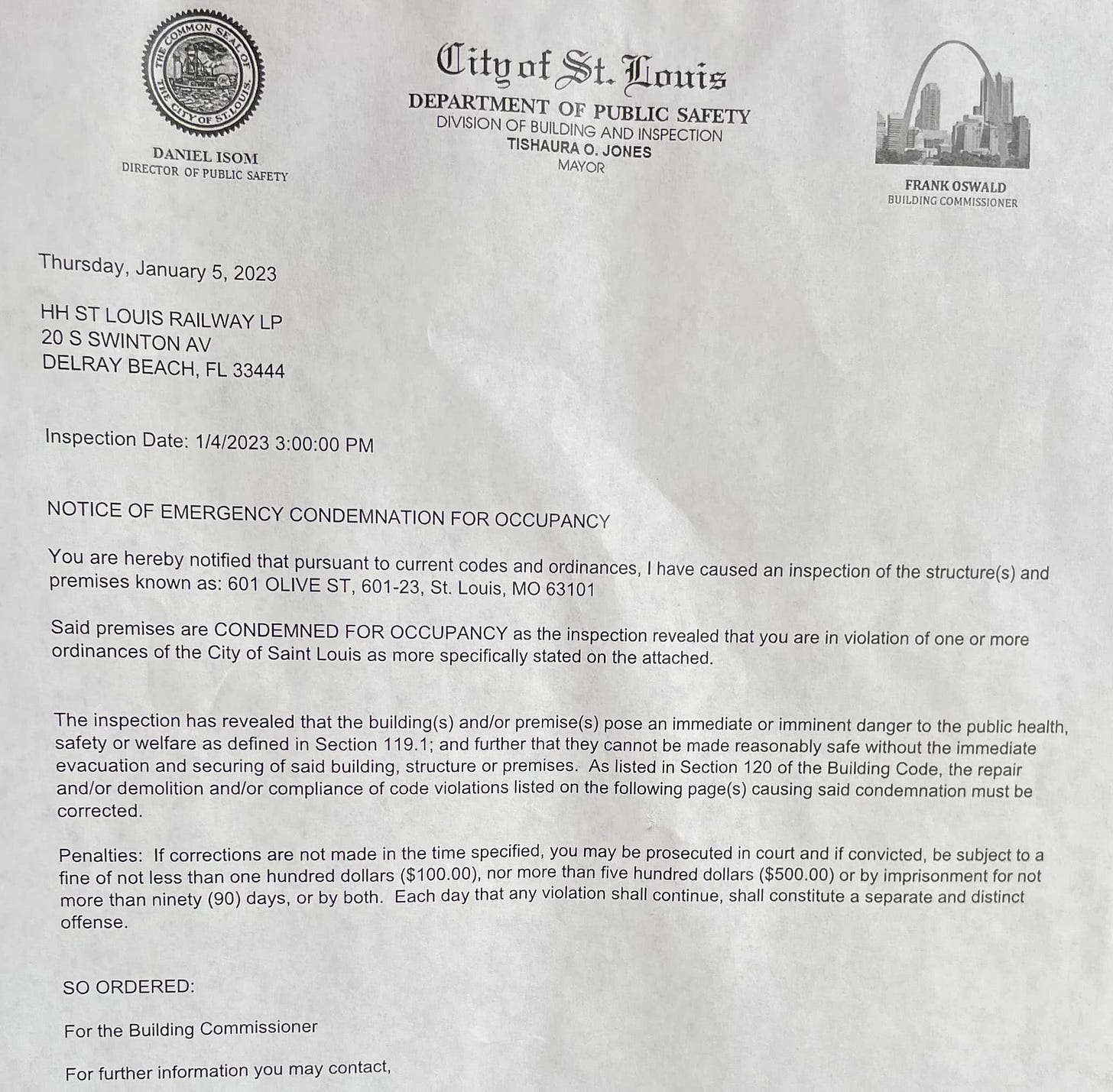
Usually, news like that would strike fear into architectural preservationists, but in this case, it may be what the building needs to survive. Kurt Weigle, senior vice president and chief downtown officer for Greater St. Louis Inc., told Fox 2 News,
“For the mayor to take that action is really important for preserving that building, preserving that asset, so we can get to the business of redeveloping it…cities are judged by their downtowns. Rightly or wrongly, they are judged by their downtowns.”
As the St. Louis Post-Dispatch noted, this move “could eventually clear the way for the long-awaited redevelopment of a major city landmark.”
After the order was issued, the St. Louis Building Division boarded up the building, and one of the managers there, Ed Ware, explained how they
“hope that our partners at the City Counselor’s office will help us in getting this owner to either sell the property to a responsible owner or step up and be a responsible owner.”
Weigle pointed out that the Railway Exchange Building is “one of our biggest assets.”
In February, a news update indicated that the City of St. Louis Building Division has decided to go after the absentee owner, Hudson Holdings of Florida.
The St. Louis City Counselor's Problem Property Attorney contacted Hudson Holdings to clarify their responsibilities, and a private security firm has been hired to patrol the site around the clock and close up any openings where the building’s interior is accessible through boards that have been cut or pried away from windows.
John McLaughlin, head of the City of St. Louis Problem Properties unit, told Fox 7, “Our efforts are to hold the owner accountable for maintaining and securing his property and being a good neighbor downtown.”
It’s unclear whether Hudson responded or has agreed to take any action.
What will the future hold?
The goal of the City of St. Louis is to save the Railway Exchange Building. The size, nature, and history of the building are impossible to ignore, and the fond memories of so many residents make it hard for leaders to turn their backs on this important structure.
Because the building is condemned, many hope that the City will take action against the delinquent owners and that new owners will develop plans that will save the structure. Unfortunately, this will take time and considerable investment. For now, unless someone has some spare millions sitting around, all we can do is cross our fingers that things work out before something tragic happens.
As always, thanks for reading Unseen St. Louis and supporting my work. These articles and our new speaker series take a lot of my time to produce, and it can be a challenge to balance this work alongside my paid work. Financial support will make Unseen STL sustainable into the future, and to this end, please consider upgrading to a paid subscription.
Sources:
Amanda St. Amand, Remembering St. Louis department store holiday windows, St. Louis Post-Dispatch, December 15, 2022.
Andy Banker, Growing calls to save the old Famous-Barr building, Fox 2 News, January 12, 2023.
Andy Banker, St. Louis going after absentee owner of Famous Barr building, Fox 2 News, February 16, 2023.
The birth and ultimate demise of St. Louis Centre, the downtown mall, St. Louis Post-Dispatch, August 8, 2022.
Michael Hamtil, Photos: The Railway Exchange, once home to Famous-Barr and Macy's in downtown St. Louis, St. Louis Post-Dispatch, January 12, 2023.
Paul Hohmann, St. Louis Centre Part Five - The End of the Mall, Vanishing STL, May 2, 2012.
In postwar St. Louis, downtown was the place to be at Christmas, St. Louis Post-Dispatch, November 30, 2022.
Steph Kukuljan, St. Louis condemns downtown’s Railway Exchange Building, setting stage for redo, St. Louis Post-Dispatch, January 12, 2023.
Steph Kukuljan, St. Louis’ Railway Exchange ‘held hostage’ by past attempts, preservationist says, St. Louis Post-Dispatch, October 11, 2022.
Jaime Lees, St. Louis Then and Now: The Former Famous-Barr Building Downtown, The Riverfront Times, December 22, 2020.
Chris Naffziger, The Railway Exchange Building, St. Louis Patina, January 23, 2009 .
Railway Exchange Building, Built St. Louis.
David J. Simmons, The Railway Exchange Building Turns One Hundred Years Old, The Society of Architectural Historians Missouri Valley Chapter Newsletter, Fall 2013.
Frank Trampe, A History of the Railway Exchange Building, National Building Arts Center, 2020.
St. Louis Centre Was A Design Failure From Day One Urban Review | St. Louis, January 8, 2006.

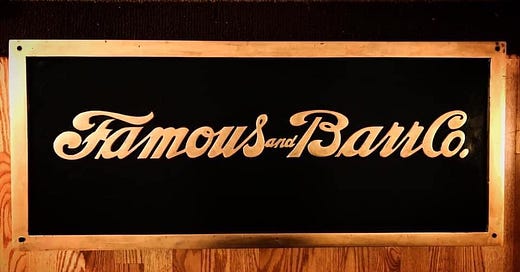






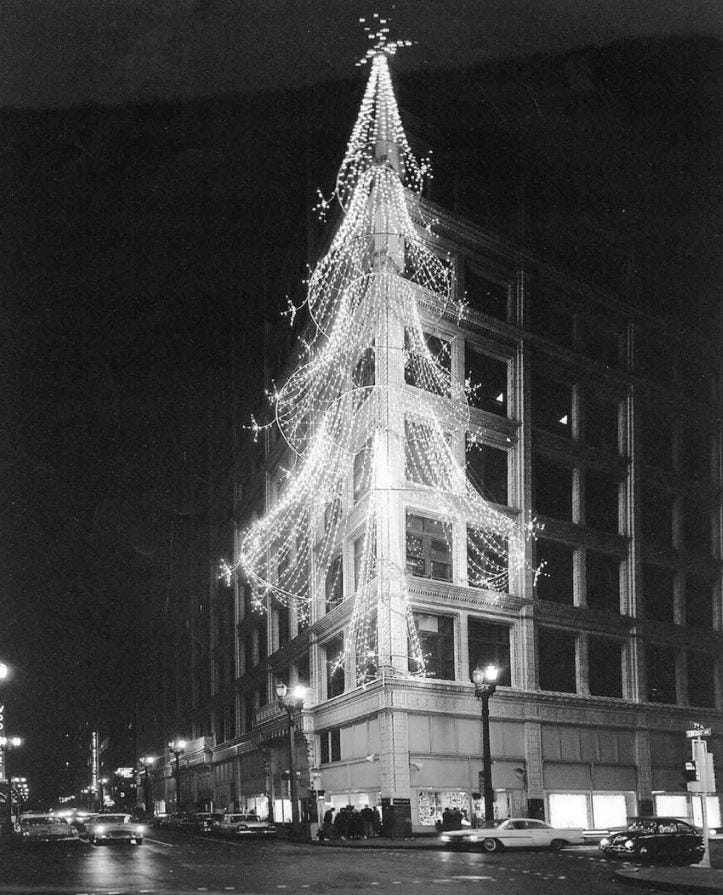
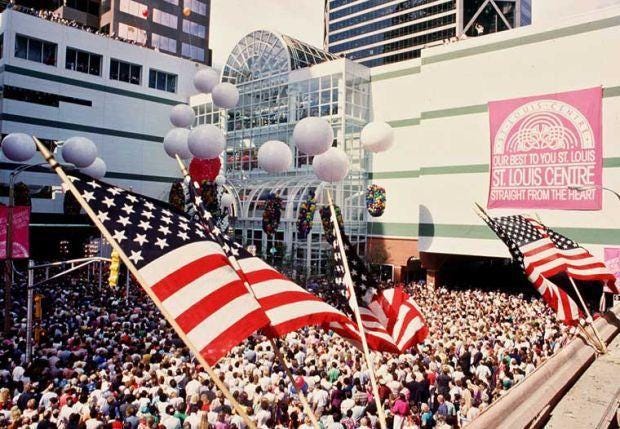
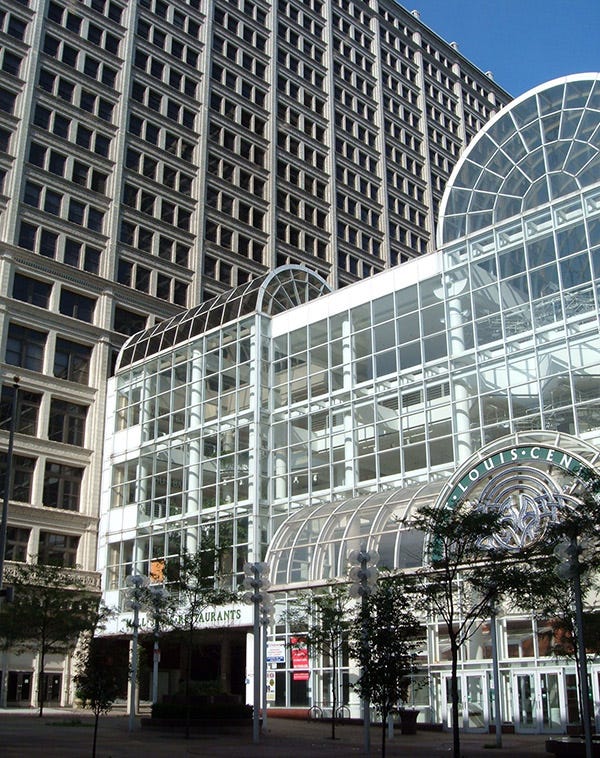
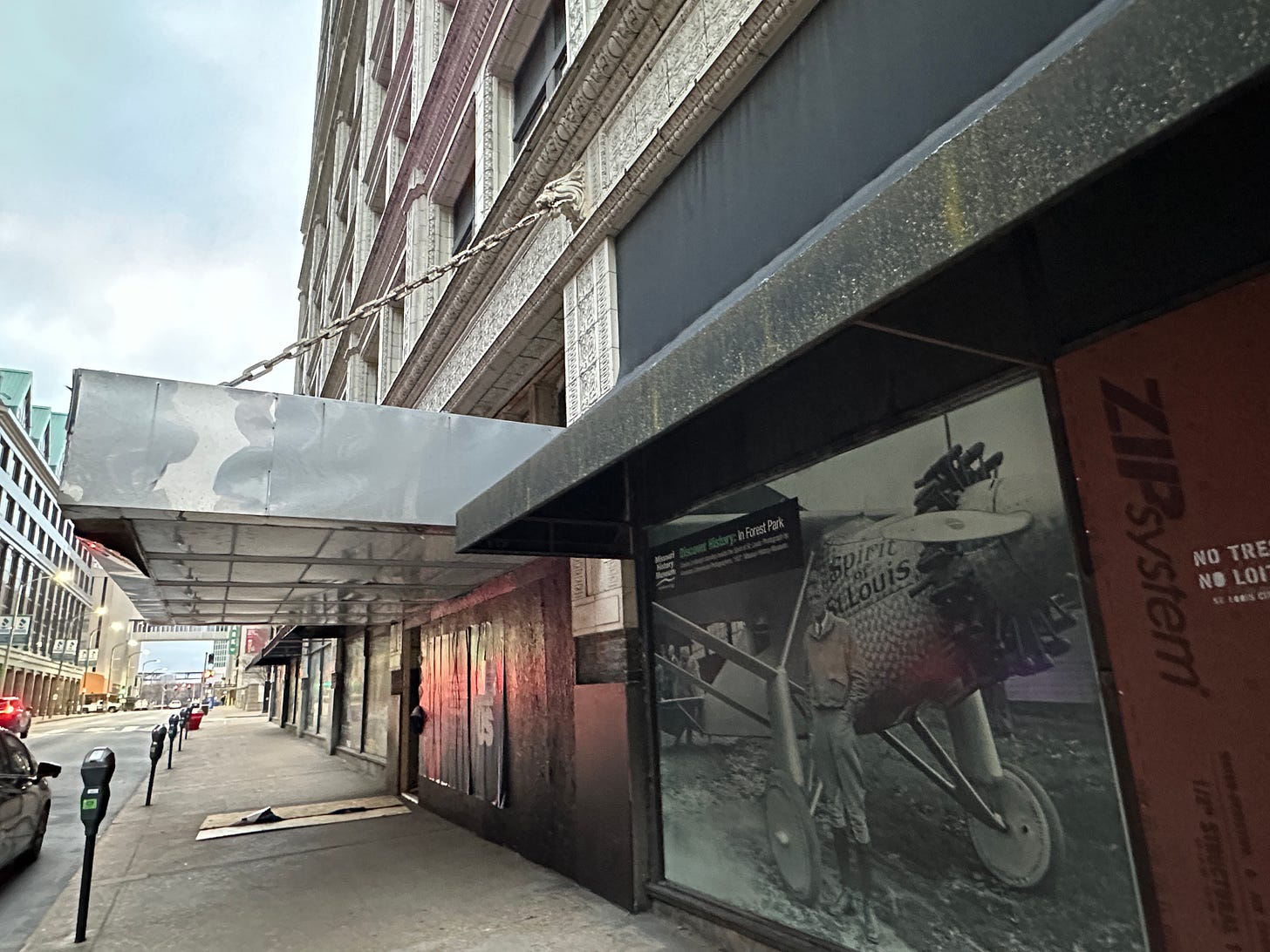
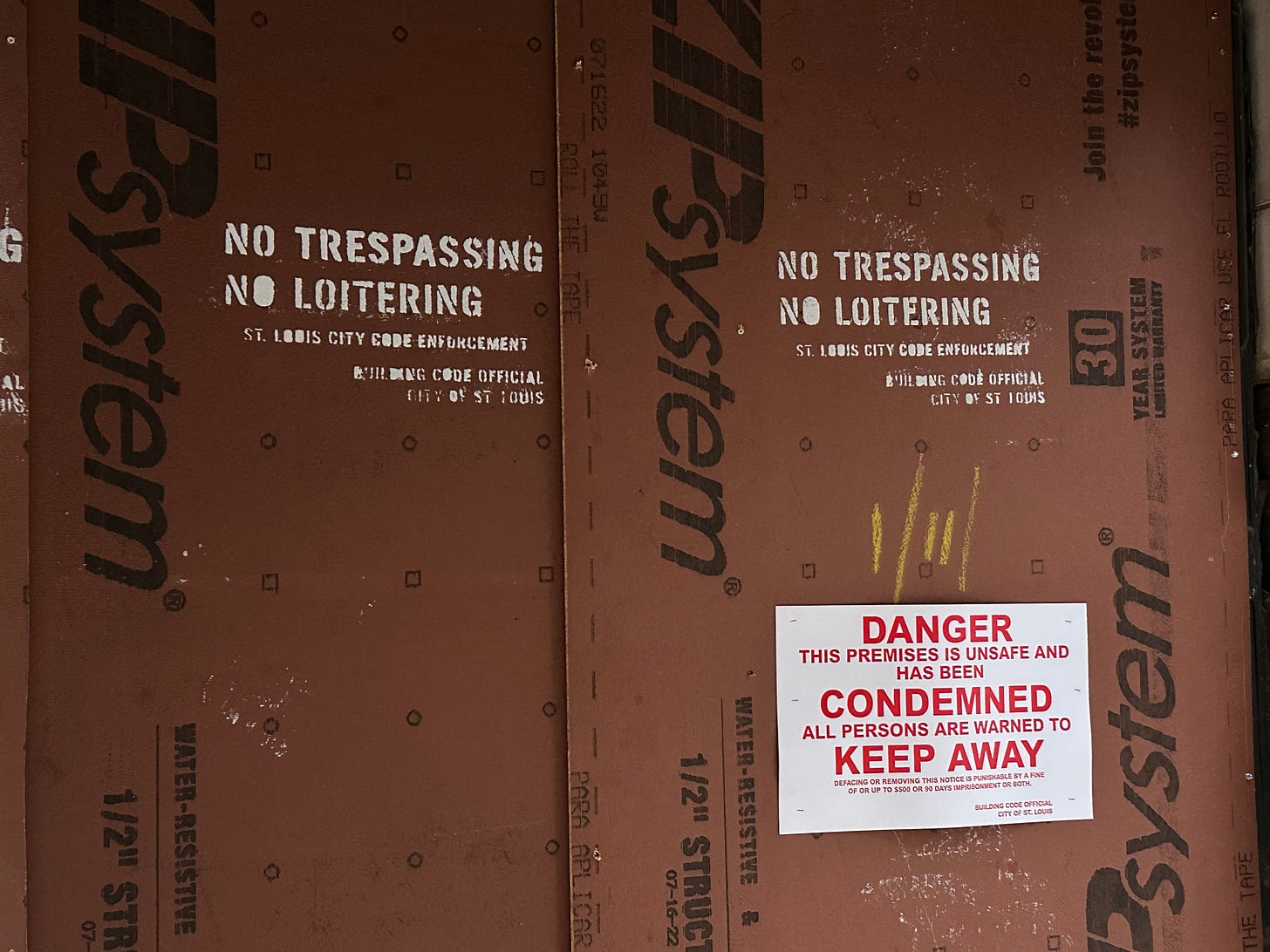

I workout at the Y across the street from Railway Exchange /Famous Barr and we have watched with great interest to see if this beautiful building will be saved. Thanks for the great piece of history.
Great article, but it erroneously states “ the Railway Exchange Building was sold by Dayton-Hudson Corporation to Federated Department Stores”. The Railway Exchange Building was owned by The May Department Stores Company and was “sold” to Federated Department Stores (now known as Macy’s Inc.) during Federated’s$11 billion acquisition of May in 2005.
On a side note, Dayton Hudson changed its name to Target Corporation in 2000, five years before Federated bought May. May Company purchased Marshall Field’s from Target Corporation in 2004 for $3.2 billion dollars.